Nestled within the picturesque landscapes of Maharashtra, lies the captivating town of Jejuri beckoning travellers and the devout with its historical allure, breathtaking vistas and array of ancient temples, the most prominent being the Khandoba Temple. This idyllic destination is a true gem waiting to be explored, says Nandini Rao. With its rich cultural heritage and profound spiritual significance, Jejuri offers an immersive experience that leaves an indelible mark on all who venture here.
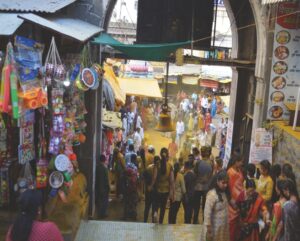
As one sets foot in Jejuri, they are greeted by the awe-inspiring sight of the Khandoba Temple, a revered landmark that dominates the town’s skyline. This ancient shrine, dedicated to Lord Khandoba, stands as a testament to architectural brilliance and holds deep religious importance for countless devotees. The grandeur and vibrant aura of the temple reach their zenith during festivals, attracting multitudes of pilgrims from far and wide.
Every aspect of Jejuri, a municipal council in Purandar taluka of Pune district, is worth a visit. Strolling along the winding alleys of Jejuri, visitors are bound to stumble upon hidden treasures at every turn. The town’s charming bazaars present a delightful shopping experience, where one can indulge in traditional handicrafts, vibrant textiles, and exquisite jewellery. Engaging with the friendly locals, known for their warm hospitality and delicious snacks, and enthralling tales of the region’s history, offers a window into the treasure trove of culture of the lively town.
For nature enthusiasts, Jejuri’s surrounding hills provide solace and tranquillity. The rugged terrain, adorned with lush greenery and dotted with ancient forts, offers breathtaking views. These natural wonders serve as a perfect retreat, providing respite from the hustle and bustle of city life. A trek on the picturesque slopes of Vetal Hill, also known as Vetal Tekdi, rewards adventurers with spectacular views of the green countryside. Vetal Hill, with an elevation of 800 meters, has a temple of Vetala atop the hill from which the name is derived. There is an observation deck also which is maintained by the Indian Forest Department.
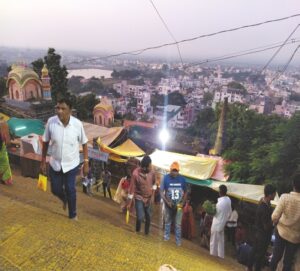
In 1739, a general of the Maratha Empire and brother of Peshwa Bajirao, Chimaji Appa, defeated the Portuguese in the Battle of Vasai. Soon after, Appa and his men took out 38 church bells from Portuguese churches and installed them in 34 temples across Maharashtra, including one at Jejuri’s Khandoba Temple.
Formidable forts and ancient temples
Apart from the rich history bundled up in the temple town, Jejuri’s rich historical legacy also comes alive through the formidable forts located in the vicinity of the temple town, many of which played a pivotal role in the rise of the Maratha Empire. Amidst the ancient ramparts and majestic gateways, one can delve into tales of valour that resonate through the fort’s storied past. The strategic location atop a hill offers a commanding vista of the surrounding plains, leaving visitors awe-struck by its architectural grandeur.
Beyond the forts, Jejuri’s historical significance manifests in its ancient temples, particularly the Khandoba Temple. Jejuri is a famous pilgrimage place where Lord Khandoba devotees visit their beloved god from far and wide. Khandoba, also known as Malhari and Martand, is a manifestation of Lord Shiva. Khandoba is revered and worshipped by many castes and communities in Maharashtra, as a clan god. Khandoba’s wives Banai and Mhalsa belong to the nomadic shepherd tribe called the Dhangars and the Lingayats of Karnataka, respectively.
Jejuri is home to two temples of Lord Khandoba, an old one and a new one, both situated separately on the descending Purandar range that skirts the pilgrim town. The new temple is larger and located at a height of 250 feet. The older temple, on the other hand, is smaller in size and built on a plateau known as Kadepathar, about 400 feet higher, a couple of miles away, and believed to be more sacred. The Kadepathar plateau spans about eleven acres and houses several other shrines and temples. The old village is now deserted and has a lake in its vicinity known as the Peshwa Lake built by the last Peshwa, Bajirao II.
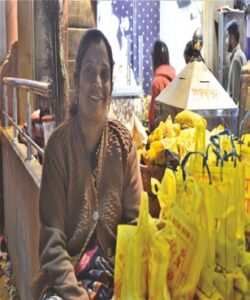
The temples of Jejuri exemplify spectacular architecture and art. Intricate rock-cut sculptures and ancient inscriptions adorn these mystical spaces, evoking a sense of wonder and admiration for the artistic prowess of bygone generations. Exploring these sacred enclaves is a journey of discovery and a testament to the town’s cultural heritage.
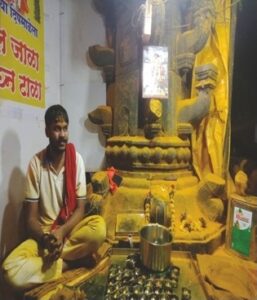
To fully immerse oneself in Jejuri’s vibrance, timing one’s visit during the town’s lively festivals is a must. The exuberant celebrations of Holi, where locals come together to revel in a riot of vibrant colours, create an atmosphere of joy and camaraderie. The festival of Diwali illuminates Jejuri with a mesmerising display of lights and fireworks, enveloping the town in an enchanting aura that lingers in the memories of all fortunate enough to witness it.
One of the most important festivals observed in Jejuri is Champa Shashti – a festival dedicated to Lord Shiva and mainly celebrated in Karnataka and Maharashtra region. The festival falls on the sixth day in the Margashirsha month during the Shukla Paksha and is widely celebrated in Jejuri where millions of devotees gather to offer prayers to Khanderao or Khandoba, an incarnation of Lord Shiva.
Another important festival is Somavati Amavasya, which is the no moon day that falls on a Monday. On this day, millions of devotees of Lord Khandoba gather at the temple carrying turmeric powder, known as ‘Bhandara’. Revellers throw turmeric in the air and smear it on oneself and each other, singing and dancing all along. Owing to the colourful celebration, the pilgrim town has earned the name ‘Sonyachi Jejuri’ which translates to ‘golden Jejuri’. Devotees bathe in yellow turmeric powder and offer penance on this day.
Other important occasions each with a religious or cultural significance at Jejuri include Chaitra Purnima, Guru Purnima, Shravan Purnima, Ghatasthapana, Dussera, Paush Purnima, Mahashivratri, etc.
A religious epicentre
Jejuri is home to one of the most revered temples in Maharashtra, the Khandoba Temple, and is also known as Khandobachi Jejuri for that reason. Khandoba is worshipped with high reverence by the Dhangars and is regarded as the ‘God of Jejuri’. On 14 September 1752, a historic treaty between Tarabai and Balaji Bajirao was made here.
As one ascends the hill to reach the temple, a sense of anticipation fills the air. The gentle breeze carries with it the scent of incense and the sound of devotional hymns played by the Gondhalis, heightening the spiritual ambience that envelops the sacred site. The panoramic views that unfold along the way provide a heart-stopping glimpse of the surrounding landscapes, further enhancing the sense of reverence and tranquillity.
The temple’s architectural brilliance and intricate craftsmanship leave visitors in awe of the devotion and skill that went into its construction. The tall spires, adorned with vibrant colours, reach towards the heavens, creating a captivating sight against the backdrop of the azure sky. The electrifying spiritual vibe of the zone can only be experienced in person.
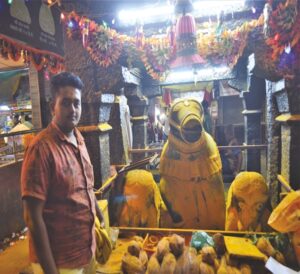
Lavthaleshwar Temple is another famous Shiva temple that is located between the towns of Jejuri and Saswad in Pune district. It is a small, simple temple that is located underground. Lavthaleshwar houses a Shivaling and Nandi and an idol of Naga in front of the temple. They say that ‘Lavthavati Vikrala Brahmandi Mala’ – Lord Shiva’s famous prayer or Shankar aarti was written in this temple by Samarth Ramdas Swami.
Beyond their religious significance, temples in Jejuri offer a respite from the chaos of everyday life. The quiet surroundings, coupled with picturesque landscapes unfolding from the hilltop, create an atmosphere of peace. Visitors can sit in quiet contemplation, allowing the serenity of the surroundings to wash over them, and find solace in the embrace of nature and the spiritual energy that permeates the temples.

Apart from the temple, Jejuri offers additional attractions for tourists. The town is known for its ancient fort, popularly known as the ‘Jejuri Gad’ which provides a panoramic view of the surrounding landscape. Jejuri is also famous for its step wells showcasing excellent craftsmanship and engineering skills of ancient times.
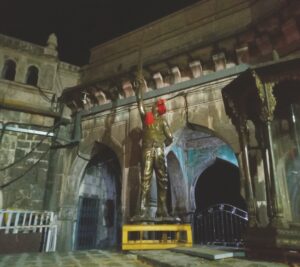
Unique traditions
The Khandoba Temple is famous for its unique traditions and rituals. One of the most interesting rituals is the showering of the deity with turmeric powder, known as the ‘Bhandara’. Devotees participate in this vibrant ceremony, covering the idols of Lord Khandoba and each other in a golden hue of turmeric.
This practice is symbolic of Lord Khandoba’s association with the colour yellow and his victory over evil forces. The temple premises come alive with devotional chants, music and a festive atmosphere during this ritual. Devotees throw turmeric powder in the air as they climb up the steps of ‘Jejuri Gad’ or the fort to reach the temple, filling the air with yellow colour throughout. The phrase that they say while showering people as they climb is ‘Yelkot yelkot jai malhar.’
It has become a cherished tradition among newlyweds to embark on a pilgrimage to Jejuri, wherein lies the revered Khandoba Temple. This holy expedition entails a momentous act, as the husband gallantly lifts his wife and ascends the imposing stone steps, signifying their commitment and strength as a united couple. It is one of the most prominent customs observed at Khandoba Temple. The practice symbolises strength, unity, and devotion within a marriage. It is believed that by lifting their wives, grooms demonstrate their ability to protect and support their life partners throughout their marital journey.
As couples enter the temple premises adorned with vibrant decorations and an air of sanctity, they immerse themselves in an enchanting atmosphere filled with love and faith. Husbands prepare themselves mentally and physically for the impending task. With each passing moment, anticipation builds as they await their turn to lift their beloved wives.
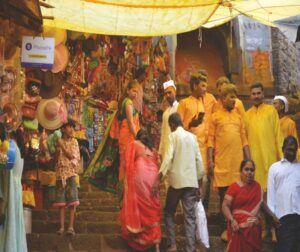
When finally called upon by the temple priest to perform this remarkable act, grooms approach their radiant brides with confidence shining in their eyes. Amidst a symphony of laughter, cheers, and jubilant exclamations, families and friends encircle the radiant couple as they prepare for their momentous lift. The excitement builds as each husband prepares to hoist his beloved bride into his arms. The anticipation is palpable – an electrifying energy that courses through every onlooker.
And then it happens – with a surge of strength and determination, husbands effortlessly raise their wives high above their heads. In that fleeting moment suspended in time, a profound connection between two souls is manifested. It is a testament to their unwavering bond and shared dreams for a blissful future together.
The collective resonance of applause echoes through the temple walls as each couple completes this symbolic act. The beaming smiles on both husband and wife are infectious – mirroring the elation experienced by those who have found love and chosen to embark on this sacred journey called marriage.
This ritual is not unnoticed, as eager relatives seize the opportunity to immortalise this tender, symbolic gesture by capturing it on their trusted mobile devices. Additionally, some devotees choose to enhance the moment further by seeking the services of professional photographers, who cater exclusively to those ascending towards the sublime abode of Khandoba.
Seeped in history
One of the most beautiful landmarks in Jejuri is the Bajirao Peshwa Lake that stands as a tranquil oasis, inviting visitors to immerse themselves in its serene still waters and rich historical legacy. Named after the legendary Maratha warrior and statesman, Bajirao Peshwa, this expansive lake offers a respite from the bustling city life and a chance to connect with nature in all its splendour. Exploring the environs of the Bajirao Peshwa Lake reveals a myriad of delights for nature enthusiasts and adventure seekers alike. Visitors can delve into the stories and legends associated with Bajirao Peshwa, gaining insights into his remarkable life and the historical events that unfolded during his time.
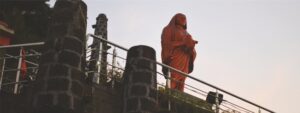
Bajirao I, born as Visaji, was the 7th Peshwa of the Maratha Confederacy who, during his 20-year rule as a Peshwa, defeated Nizam-ul-Mulk several times. These include in the battles of Bhopal and Palkhed. He is considered as one of the greatest cavalry generals. The Peshwa contributed in a big way to establish Maratha supremacy in Southern India and Northern India as well. He was one of the key persons in the Maratha Empire who fortified the Maratha power in the region including in Bundelkhand, Malwa, Rajputana, etc. He was also instrumental in freeing the Konkan region that was, at that time, under the Siddis of Janjira and the Portuguese rule as well.
Another important landmark in Jejuri is the statue of Ahilyabai Holkar, perched on a side along the steps of the Jejuri Gad, on way to the Khandoba Temple. Many visitors pay homage to her here. Ahilyabai Holkar, born on 31 May 1725, became the hereditary noble queen in the Maratha Empire and was instrumental in establishing Maheshwar in Madhya Pradesh as the headquarters of the Holkar dynasty.
When her husband, Khande Rao Holkar, met with an untimely death, and at the same time, her father-in-law Malhar Rao Holkar too, she took the reins in control and started administering the Holkar dynasty. She faced several hurdles but was steadfast in her determination to protect her people. She defended the Malwa state in a fierce manner and displayed unwavering courage against invaders. She personally took charge on the battlefield with the military commander Tukoji Rao Holkar.
However, it was not solely through her military prowess that Ahilyabai distinguished herself. She was a trailblazing visionary, known for her unwavering commitment to constructing Hindu temples that echoed throughout the expanse of India. Her legacy is one of unparalleled devotion, as she oversaw the construction of hundreds of temples and Dharamshalas, serving as sanctuaries for the devout and pious, scattered across the nation. Her place on the foothills below the Khandoba Temple is the perfect tribute to her contributions to society.

